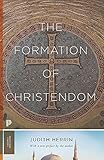The Formation of Christendom / Judith Herrin.
Material type: TextPublisher: Princeton, NJ : Princeton University Press, [2021]Copyright date: ©1987Description: 1 online resource (568 p.) : 3 maps. 16 b/w illusContent type:
TextPublisher: Princeton, NJ : Princeton University Press, [2021]Copyright date: ©1987Description: 1 online resource (568 p.) : 3 maps. 16 b/w illusContent type: - 9780691220772
- Church history -- Middle Ages, 600-1500
- HISTORY / Medieval
- Abbasid Revolution
- Adoption
- Al-Andalus
- Alexandrian school
- Anno Domini
- Apostolic succession
- Arabs
- Austrasia
- Autun
- Bible
- Biblical authority
- Byzantine Empire
- Byzantium (color)
- Byzantium
- Caesarius of Arles
- Caliphate
- Cassiodorus
- Charlemagne
- Charles Martel
- Christendom
- Christian culture
- Christian monasticism
- Christian worship
- Christian
- Christianity and Islam
- Christianity
- Christianization
- Chronology of the Bible
- Church discipline
- Clergy
- Constans II
- Constantinople
- Diocletian
- Duchy of Rome
- Duke of Aquitaine
- Early Christian art and architecture
- Ecclesiastical History of the English People
- Ecclesiology
- Ecumenical council
- Episcopal see
- Feudalism
- Gazetteer
- Hadith
- Harun al-Rashid
- Henri Pirenne
- Holy Roman Empire
- Iconoclasm
- Imperialism
- Islam
- Jihad
- Judeo-Christian
- Late Antiquity
- Latin Church
- Middle Ages
- Missionary
- Mithraism
- Monemvasia
- Monotheism
- Muslim
- Nativity of Jesus
- Neustria
- New Israel
- New Testament
- New religious movement
- Old Testament
- Orosius
- Patriarchate
- Pentarchy
- Pontiff
- Pope Gregory I
- Pope John I
- Pope Leo III
- Pope Stephen II
- Pope
- Preface (liturgy)
- Profession of faith (Catholic Church)
- Proscription
- Quran
- Religion
- Saint Boniface
- Septimania
- Shahada
- Spirituality
- Spread of Christianity
- Spread of Islam
- Summa Theologica
- Synod
- Systematic theology
- Tegernsee
- Tervel (town)
- The Creation of Adam
- The Rise of the West
- Theology
- Tithe
- Umayyad Caliphate
- Visigoths
- Western Christianity
- Western thought
- Worship
- Zoroastrianism
- 209/.4
- online - DeGruyter
| Item type | Current library | Call number | URL | Status | Notes | Barcode | |
|---|---|---|---|---|---|---|---|
 eBook
eBook
|
Biblioteca "Angelicum" Pont. Univ. S.Tommaso d'Aquino Nuvola online | online - DeGruyter (Browse shelf(Opens below)) | Online access | Not for loan (Accesso limitato) | Accesso per gli utenti autorizzati / Access for authorized users | (dgr)9780691220772 |
Browsing Biblioteca "Angelicum" Pont. Univ. S.Tommaso d'Aquino shelves, Shelving location: Nuvola online Close shelf browser (Hides shelf browser)

|

|

|

|

|

|

|
||
| online - DeGruyter The Ways of Zen / | online - DeGruyter Uncivil Mirth : Ridicule in Enlightenment Britain / | online - DeGruyter For the Many : American Feminists and the Global Fight for Democratic Equality / | online - DeGruyter The Formation of Christendom / | online - DeGruyter New Lefts : The Making of a Radical Tradition / | online - DeGruyter Agents of Reform : Child Labor and the Origins of the Welfare State / | online - DeGruyter Liberalism in Dark Times : The Liberal Ethos in the Twentieth Century / |
Frontmatter -- Contents -- List of Plates -- Preface to the Princeton Classics Edition -- Acknowledgements -- Introduction -- PART I. LATE ANTIQUITY -- 1. Map of the World of Late Antiquity -- 1. Romans and Non-Romans -- 2. Christian Influence in Late Antique Culture -- 3. The Churches in the Sixth Century: The Council of 553 -- PART II. FROM CHRISTIAN SCHISM TO DIVISION -- 2. Map of the Mediterranean East -- Introduction to Part II -- 4. The Achievement of Gregory the Great -- 5. Byzantium Confronted by Islam -- 6. The Visigothic Alternative -- 7. The Roots of Christian Disunity, 649-92 -- PART III. THE THREE HEIRS OF ROME -- 3. Map of the Christian West -- Introduction to Part III -- 8. Eastern Iconoclasm: Islamic and Byzantine -- 9. Divergent Paths -- 10. The Carolingian Innovation -- 11. The Two Emperors of Christendom -- 12. Conclusion -- Afterword -- Abbreviations -- Index -- 4. Comparative Chronology
restricted access online access with authorization star
http://purl.org/coar/access_right/c_16ec
In a lucid history of what used to be termed "the Dark Ages," Judith Herrin outlines the origins of Europe from the end of late antiquity to the coronation of Charlemagne. She shows that the clash between nascent Islam and stubburn Byzantium was the central contest that allowed "Europe" to develop, and she thereby places the rise of the West in its true Mediterranean context. Her inquiry centers on the notion of "Christendom." Instead of taking medieval beliefs for granted or separating theology from politics, she treats the faith as a material force. In a path-breaking account of the arguments over Christian doctrine, she shows how the northern sphere of the Roman world divided into two distinct and self-conscious imperial units, as the Arabs swept through the southern regions.One of the most interesting strands of the author's argument concerns religious art and iconoclasm. Her book shows how the impact of Islam's Judaic ban on graven images precipitated both the iconoclast crisis in Constantinople and the West's unique commitment to pictorial narrative, as justified by Pope Gregory the Great.
Mode of access: Internet via World Wide Web.
In English.
Description based on online resource; title from PDF title page (publisher's Web site, viewed 29. Jun 2022)


